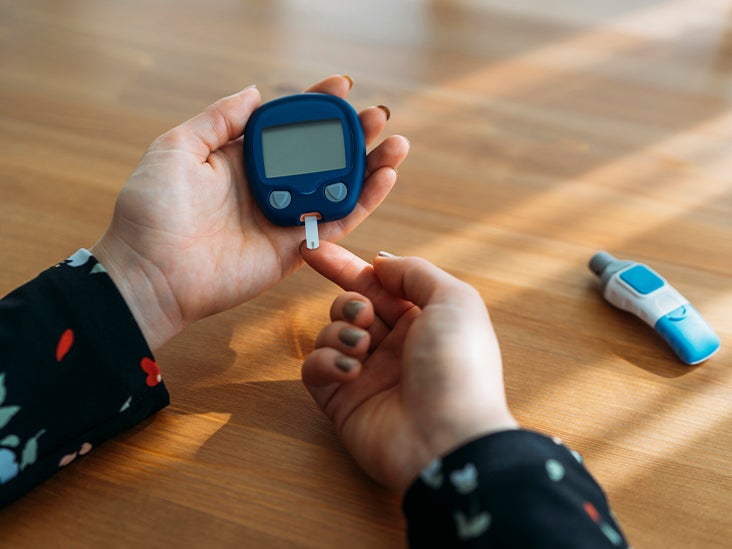Hyperglycemia vs Hypoglycemia
Published (updated: ).

Hypoglycemia
Low blood glucose, also called low blood sugar or hypoglycemia, occurs when the level of glucose in your blood drops below what is healthy for you. For many people with diabetes, this means a blood glucose reading lower than 70 milligrams per deciliter (mg/dL). Your number might be different, so check with your doctor or health care team to find out what blood glucose level is low for you.
How common is low blood glucose?
Low blood glucose is common among people with type 1 diabetes and among people with type 2 diabetes who take insulin or some other diabetes medicines. In a large global study of people with diabetes who take insulin, 4 in 5 people with type 1 diabetes and nearly half of those with type 2 diabetes reported a low blood sugar event at least once over a 4-week period.
Severely low blood glucose, defined as when your blood glucose level drops so low you can’t treat it yourself, is less common. Among U.S. adults with diabetes who take insulin or some diabetes medicines that help the pancreas release insulin into the blood, 2 in 100 may develop severely low blood glucose each year.
Who is more likely to develop low blood glucose?
You are more likely to develop low blood glucose if you
- have type 1 diabetes
- take insulin or some other diabetes medicines
- are age 65 or older
- had low blood glucose before
- have other health problems, such as kidney disease, heart disease, or cognitive impairment
What are the symptoms of low blood glucose?
Symptoms of low blood glucose tend to come on quickly and can vary from person to person. Symptoms of low blood glucose
| Mild-to-Moderate | Severe |
|---|---|
| If your blood glucose level is low, you may feel shaky, jittery hungry tired dizzy, lightheaded, confused, irritable. Also heart palipitations, headache or inability to see or speak clearly | If your blood glucose level is very low, your brain may stop working as it should. You may lose consciousness have a seizure. Severe hypoglycemia is dangerous and needs to be treated right away. |
Hyperglycemia
Hyperglycemia means high levels of blood sugar, also known as blood glucose. Over time, it can cause major health complications in people with diabetes. Several factors can contribute to hyperglycemia, including dietary choices and a sedentary lifestyle. Regular blood glucose testing is crucial for people with diabetes. This is because many people don’t feel the effects of hyperglycemia. According to the Centers for Disease Control and Prevention (CDC), target blood glucose levels for people with diabetes are typically:
- between 80 and 130 mg/dL before you’ve eaten
- under 180 mg/dL 2 hours after the first bite of your meal
Blood sugar levels that are higher than that may indicate uncontrolled diabetes. However, you may not feel the effects of hyperglycemia until your blood glucose levels are very high for an extended period of time. If you experience symptoms of hyperglycemia, it’s important that you check your blood glucose levels. Hyperglycemia symptoms that may develop over several days or weeks include:
- excessive thirst
- excessive urination, which may occur at night
- blurry vision
- fatigue
- sores that won’t heal
The longer the condition is left untreated, the more severe it may become. Long-term effects of hyperglycemia include:
- eye disease
- kidney disease
- cardiovascular disease
- neuropathy, or nerve damage
Kussmaul’s Breathing – An interesting consequence of hyperglycemia
Kussmaul breathing is characterized by deep, rapid, and labored breathing. This distinct, abnormal breathing pattern can result from certain medical conditions, such as diabetic ketoacidosis, which is a serious complication of diabetes.
What causes Kussmaul breathing?
When it comes to Kussmaul breathing, it helps to remember that your body is always trying to find balance.
Your body maintains a steady pH level of 7.35 to 7.45. When this pH level becomes higher or lower, your body has to find ways to try make up for the pH changes. This is where Kussmaul breathing comes in.
Let’s look at some possible causes of pH changes that may lead to Kussmaul breathing.
Diabetic ketoacidosis
One of the most common causes of Kussmaul breathing is diabetic ketoacidosis, which is a serious complication most often associated with type 1 diabetes. However, it can also be caused by type 2 diabetes.
Diabetic ketoacidosis can be triggered if your body doesn’t produce enough insulin and isn’t able to process glucose properly. This can lead to dehydration, which, in turn, can cause your body to start breaking down fat for energy at a rapid rate.
The byproducts of this are ketones, which are highly acidic and can cause acid to build up in your body.
Here’s an explanation of how diabetic ketoacidosis can lead to Kussmaul breathing:
- Extra ketones in your body cause acid to build up in your blood.
- Because of this, your respiratory system is triggered to start breathing faster.
- Faster breathing helps expel more carbon dioxide, which is an acidic compound in your blood.
- If acid levels keep going up and you don’t get treatment, your body will signal that you need to take deeper breaths.
- This results in Kussmaul breathing, which is characterized by deep, fast breaths, to try to expel as much carbon dioxide as possible.
EMS response to diabetes
A primary survey will reveal a patient’s need for oxygen and/or ventilation. Once the patient blood glucose has been calculated, the next course of action will be determined. If the blood sugar is low, administering dextrose (a type of glucose) can be administered to raise the patients blood glucose level. If the blood sugar is high, EMS will often transport the patient and administer intravenous fluids.
